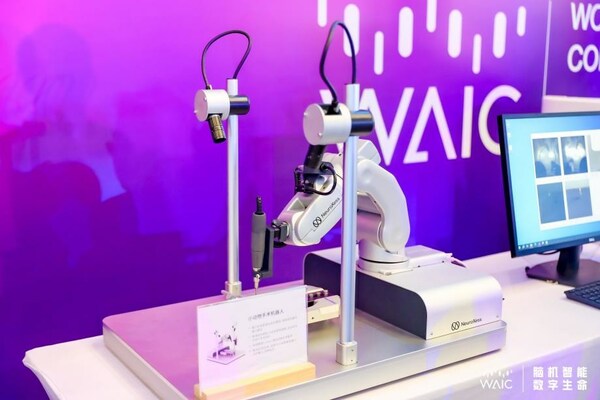NeuroXess Documents Its Multiple Achievements in Brain-Computer Interface Research at The 2023 World Artificial Intelligence Conference
SHANGHAI,July 12,2023 --On the afternoon of July 6,a forum dedicated to advances in brain-computer intelligence was held at the Shanghai World Expo Exhibition & Convention Center as a part of the 2023 World Artificial Intelligence Conference. The forum was held under the aegis of the Chinese Academy of Sciences Shanghai Branch,and was co-organized by the Shanghai Institute of Microsystem and Information Technology,Chinese Academy of Sciences (SIMIT),the Tianqiao and Chrissy Chen Institute (TCCI),the Brain-Computer Interface and Interaction Subcommittee of the Chinese Society for Neuroscience,and NeuroXess.

NeuroXess FlexShuttle Mini,a surgical robot for flexible electrode implantation
Building on last year's successful brain science forum,SIMIT assumed a leading role in this year's event,focusing on the convergence of biotechnology technology and information technology (BTIT). The event encompassed high-level academic exchanges,extensive clinical practices,and in-depth exploration of industry trends. Leading researchers from around the world congregated at the venue to share knowledge and participate in academic discussions. In collaboration with several research organizations,NeuroXess unveiled seven cutting-edge research achievements that traverse the realms of academia,scientific research,and clinical medicine within the field of brain-machine interfaces.
A presentation on the research achievements in the field of brain-computer interfaces documented the advances as they apply to academia,scientific research and clinical medicine
Brain-machine interfaces have become a focal point at the intersection of the two technologies. In the current environment where collaboration is the theme of the day,the forum,titled "Cross-Boundary Fusion," was held at the World Expo Exhibition & Convention Center,creating a perfect showcase for the smart connected world that we are now entering.
During the forum,NeuroXess delivered a presentation highlighting seven recent and important research achievements that touched on academic,research,and clinical aspects of the newly emerging field. The presentation featured video clips providing detailed insights into the research and experimental processes for each project. Notably,the presentation showcased tangible results,a new lineup of surgical robots alongside the latest solutions for advancing research in the field. On exhibit at the event and viewable to the public for the first time were the FlexShuttle and FlexShuttle Mini,two surgical robots designed for flexible electrode implantation,and the M2 brainwave acquisition chip.
Making R&D resources more available and getting buy-in from doctors on the clinical side are necessary steps to enabling further advancements in the field
Two key challenges must be addressed and resolved to progress the sector the next stage: one is identifying and engaging the right R&D resources in the research,and the other is gaining acceptance from the general public,and especially from the medical community,that BTIT is the path of the future. At the event,the Science Communication Center of Shanghai Science and Technology Museum and NeuroXess formally signed a memorandum of cooperation to jointly engage in projects that contribute to the furthering of understanding about brain science. Together,they will develop educational materials targeting both the medical community and the general public,highlighting the sector's potential and the benefits that it can deliver. The agreement was signed by Song Xian,Deputy Director of the Science Communication Center of Shanghai Science and Technology Museum,and Peng Lei,CEO of NeuroXess.
As part of the collaboration,the two parties will showcase brain-computer interface technology and research achievements to the public through documentary-style short films. Additionally,they will establish a local education program to be named the "Shanghai Popular Science Lectures" to introduce cutting-edge scientific and technological resources into classrooms and venues accessible to the general public.
After more than half a century of experimentation,brain-computer interface technology and products are gradually coming into their own. However,as an emerging technology,its research and applications still face ethical and safety challenges. To enhance the comprehension of the clinical applications of implanted brain-computer interfaces,gain the trust of medical practitioners across China and foster the necessary resources for further scientific research,the Brain-Computer Interface and Interaction Subcommittee of the Chinese Society for Neuroscience and the National Neurological Disease Medical Center (Huashan Hospital) formally co-launched the project entitled "Ethical Expert Consensus on the Medical Clinical Application of Implantable Brain-Machine Interfaces." Furthermore,the initiative aims to prevent any potential confusion that could arise in terms of diagnosis and treatment practices.
As the technological revolution enters the next round,interdisciplinary integration has emerged as a prevailing trend,and innovation-driven development has gained global consensus. The era of the metaverse,where the virtual and the real coexist,represents another dimension of the forthcoming technological revolution. With the successful conclusion of this forum and the presentation on research achievements in the world of brain-computer interfaces,NeuroXess remains committed to further exploring technological advancements in the coming year. Stay tuned for more updates!